-
 Dartmouth Sports Logo 2020
Dartmouth Sports Logo 2020 Big Green Dartmouth sports logo
-
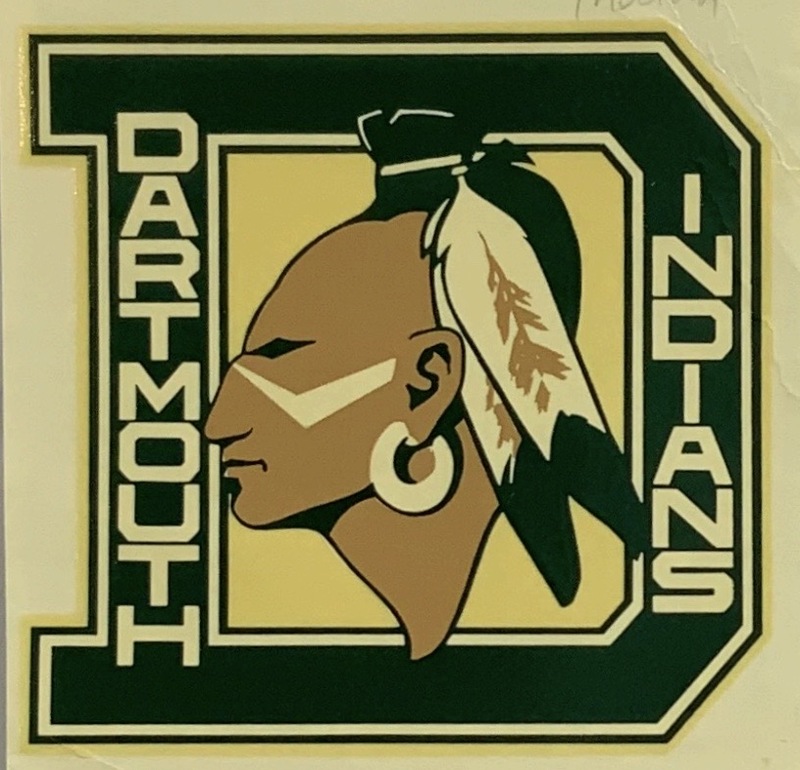 Dartmouth Indian Logo
Dartmouth Indian Logo Dartmouth D logo with Indian Head in center
-
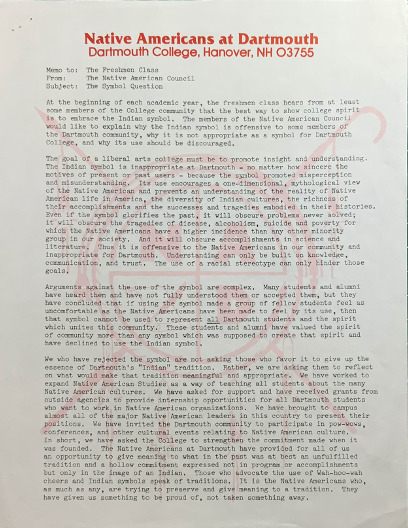 Native American Council Addresses Peers
Native American Council Addresses Peers In a letter to an undated freshman class, likely at the end of the 1970s, the Native American Council acknowledges that many members of the College community continue to embrace the Indian symbol even after its removal. The Council found it necessary to remind students that continued use of the symbol will “obscure problems never solved,” citing the higher rates of “disease, alcoholism, suicide, and poverty” in Native communities. The letter discourages the symbol’s use, much like the Board of Trustees discouraged its use in 1974, because no official action could be taken to remove a symbol never adopted by the College itself.
-
 Administrative Response to Resistance
Administrative Response to Resistance In this letter to an undergraduate student in 1974, Assistant Dean of the Faculty Gregory Prince advocated for understanding the Native American position on removing the unofficial symbol and mascot. The student, it may be assumed from Prince’s response, was not receptive to listening to the Native American students and was sympathetic to keeping it. The letter demonstrates that while many were sensitive to listening to the Native Americans in wanting to change the symbol, some students were not quick or willing to see the removal of the symbol.
-
 National Context of Native American Voices
National Context of Native American Voices This article from the Wall Street Journal puts the removal of the symbol in a national context. Around the time of Dartmouth’s removal of the Indian symbol, other schools had moved to abolish similar symbols. Additionally, debates on changing the names of national sports teams that referenced Native Americans, such as the Washington Redskins, were occurring. Native American voices were finally emerging nationally and not solely at Dartmouth. Not all attempts were successful, and Stanford University still had a Native American man dance at games even after the symbol was abolished.
-
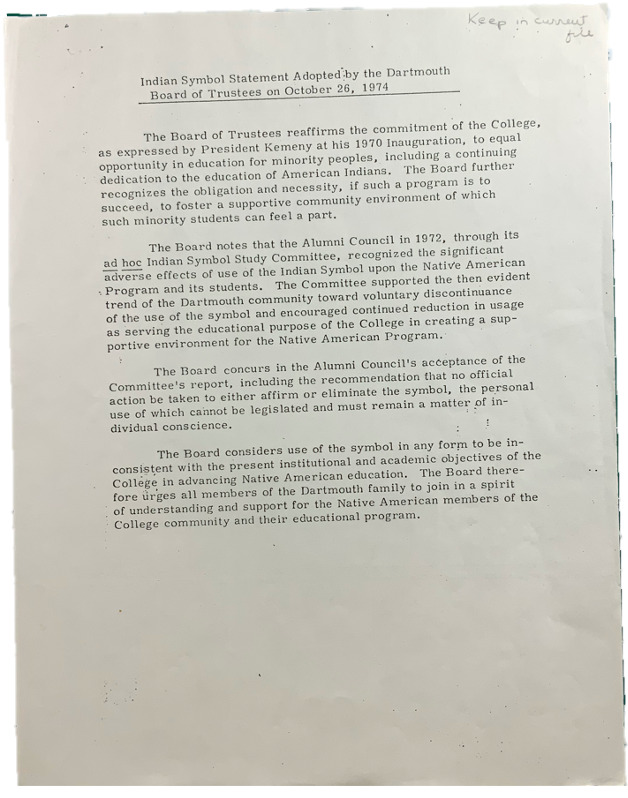 Statement from the Board of Trustees
Statement from the Board of Trustees In 1974, the Dartmouth Board of Trustees released a statement announcing “use of the [Indian] symbol in any form to be inconsistent with present institutional and academic objectives of the College in advancing Native American education.” The Board took no official action on removing the symbol because the College never formally adopted the symbol. Instead, the Board made it “a matter of individual conscience.” This statement is generally considered the official removal of the Indian symbol since it was the first time that the Board of Trustees discouraged its use.
-
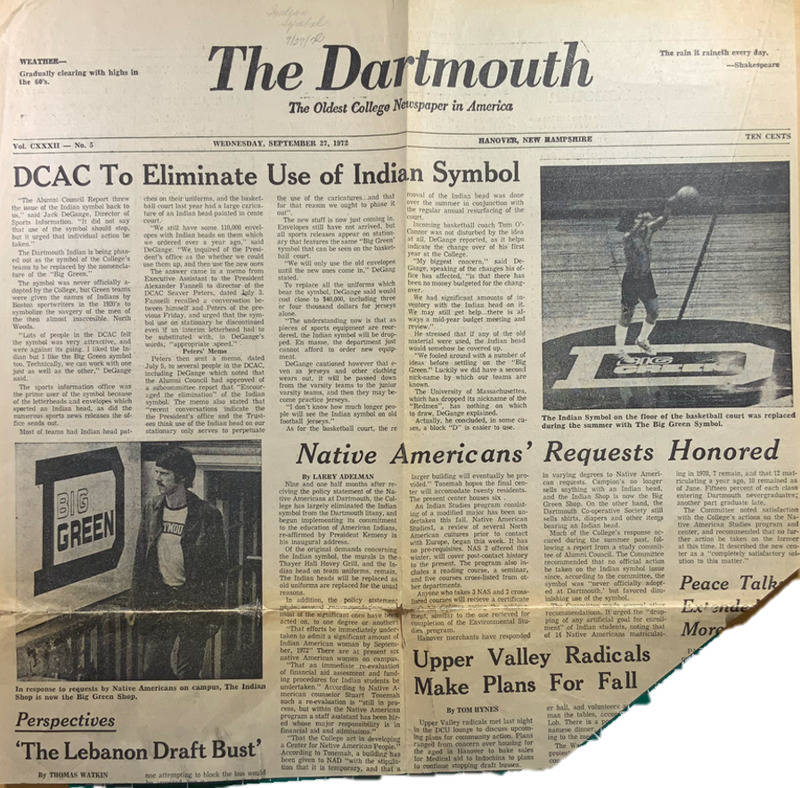 Initial Disuse of the Symbol
Initial Disuse of the Symbol The two newspaper articles from 1972, “DCAC To Eliminate Use of Indian Symbol” and “Native Americans’ Requests Honored,” announce some victories on the path to stop using the Indian symbol. “Nine and one half months after receiving the policy statement of the Native Americans at Dartmouth,” the College began the process of removing the symbol from stationary, uniforms, and changed Dartmouth’s nickname from the “Dartmouth Indian” to “Big Green.” Not all requests in the original policy statement, such as removing murals depicting Indians, were honored, and it would be several years until the symbol was completely disused on campus.
-
 Introduction to the Discussion
Introduction to the Discussion This article makes it clear that the Dartmouth administration was willing to listen to the claims made by the Native American students in their policy statement. College provost Louis Morton liked “the tone of the document” and thought that it was “a reasonably worded statement.” These words are a reminder that minorities like the Native American students needed to be careful in how they presented their grievances.
-
 Explanation Requested by the Athletic Council
Explanation Requested by the Athletic Council This letter was written five years after the College officially removed the symbol. In the letter, the Native American Council mentions that nobody objected to the symbol until it was used for athletic home game jerseys in 1970. Coincidentally, use of the symbol by the sports teams on jerseys overlapped with the admission of more Native American students to Dartmouth, and both of these events likely contributed to the development of the 1971 policy statement.
-
 Importance of Native Voices
Importance of Native Voices The article from October of 1969 notes how in the 200-year history of the College, “only a dozen” Native students graduated from Dartmouth. Without a Native American voice on campus, the symbol became “the major personification of the spirit [of the College.]” In the 1969-1970 school year, the four Native Americans on campus—three of whom were freshmen admitted after the College reaffirmed its commitment to educating Native students—began the fight against the symbol.
-
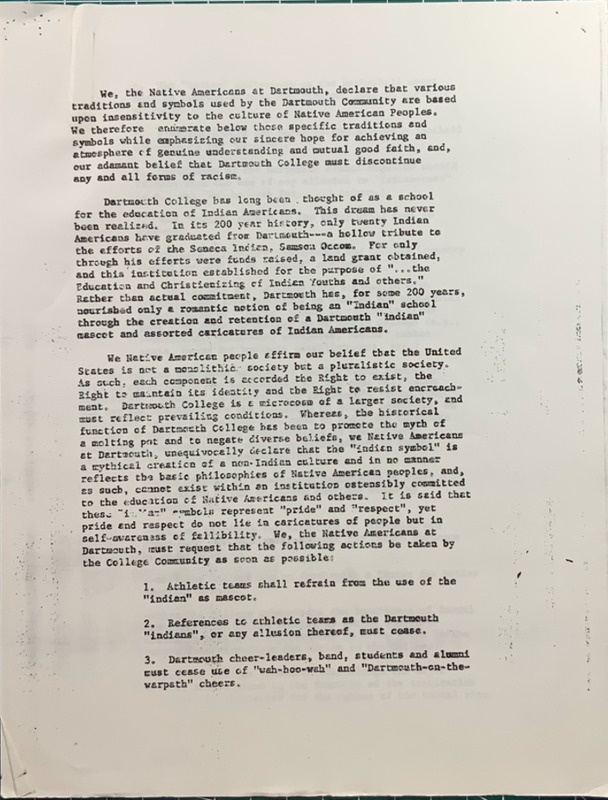 Native American Students’ Policy Statement
Native American Students’ Policy Statement This policy statement, written in 1971, was the first formal declaration by Native students that the “various traditions and symbols used by the Dartmouth Community are based upon insensitivity to the culture of Native American Peoples.” Believing the symbol was “a mythical creation of a non-Indian culture,” the Native American students requested that the College remove any depiction of Indians from campus and stop using the Indian as a mascot.
-
 Land O'Lakes new logo
Land O'Lakes new logo Land O'Lakes new logo, changed April 2020
-
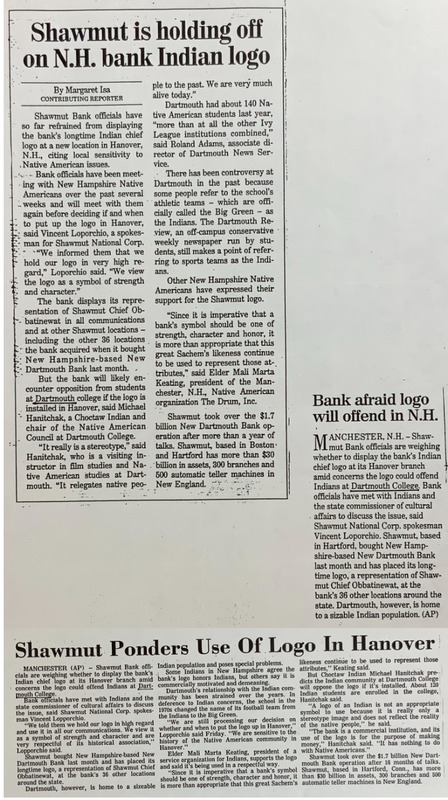 Shawmut Bank Debates, 1994
Shawmut Bank Debates, 1994 Several newspaper articles from New England described Shawmut Bank's deliberations over whether to open a Hanover branch.
-
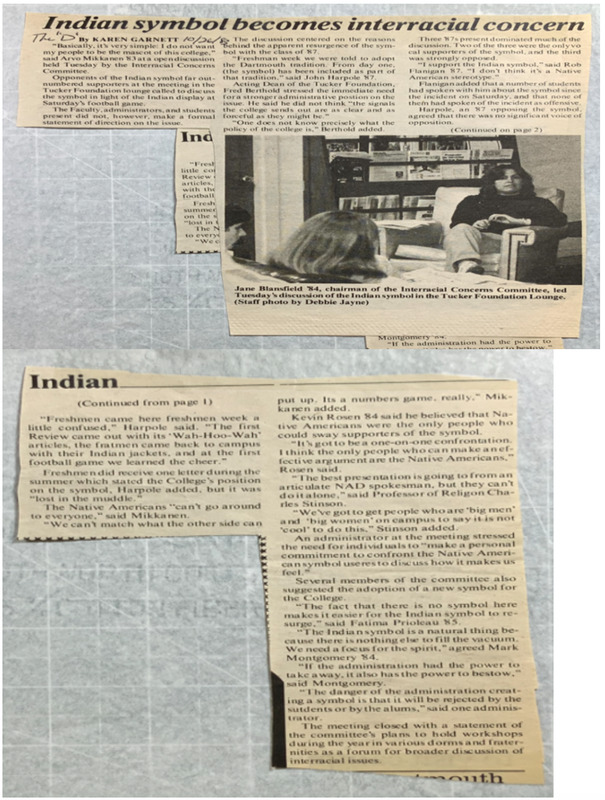 Freshman class in 1983 described "confusion" at the Dartmouth community's rejection of the Indian symbol
Freshman class in 1983 described "confusion" at the Dartmouth community's rejection of the Indian symbol Newspaper article describing a conversation between Dartmouth community members (largely students) regarding the Indian symbol
-
 Campus reaction to skaters
Campus reaction to skaters An article in the Dartmouth Alumni Magazine recounting the campus strife over the Indian symbol as well as the holding of a "Moratorium Day."
-
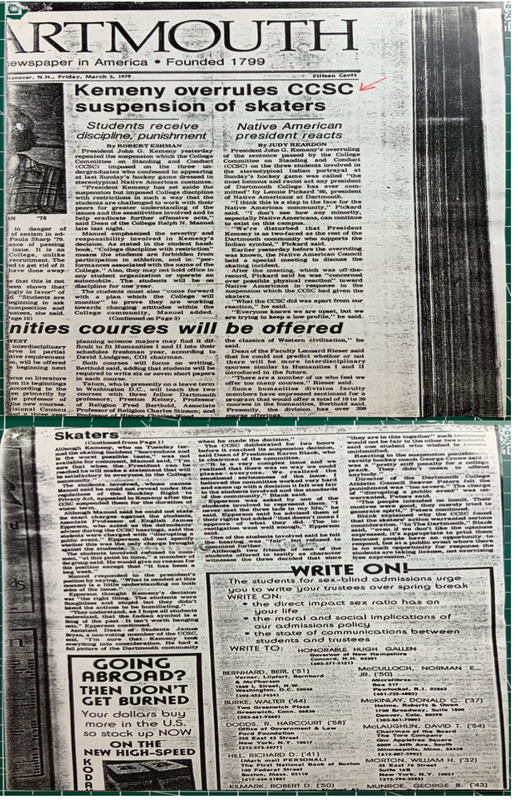 Dartmouth women dress as Native Americans at hockey game, 1979
Dartmouth women dress as Native Americans at hockey game, 1979 Articles describing an event when two freshman women dressed as Native Americans and skated on the ice with the Dartmouth hockey team.
-
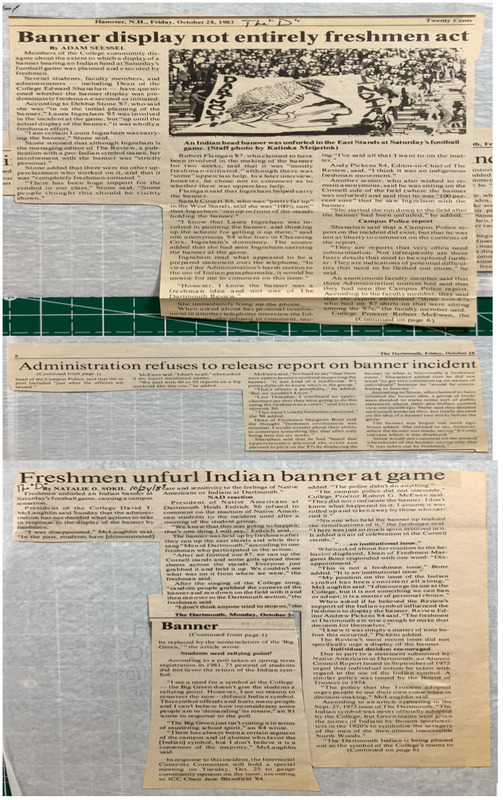 Freshman students in the fall of 1983 displayed a "Dartmouth Indians" banner at a football game
Freshman students in the fall of 1983 displayed a "Dartmouth Indians" banner at a football game The article describes and shows the event when Dartmouth students displayed a banner with the Indian symbol at a football game.
-
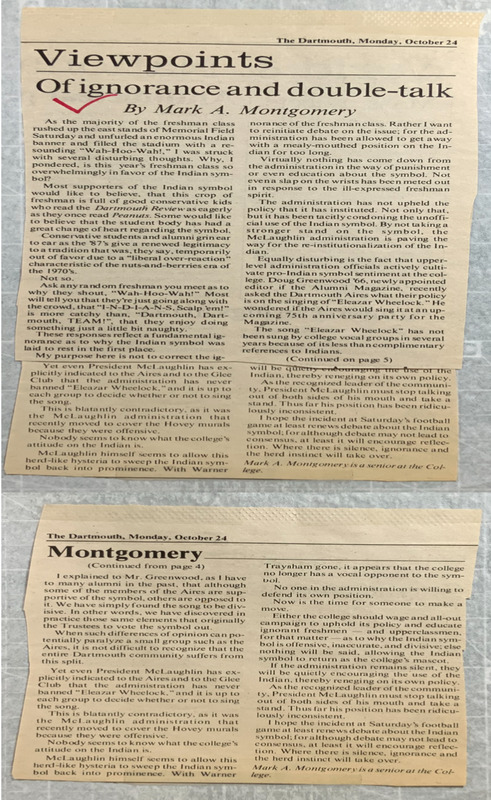 Dartmouth upperclassmen condemned the freshman class's actions in the fall of 1983
Dartmouth upperclassmen condemned the freshman class's actions in the fall of 1983 Mark Montgomery described his disgust at the freshman students' actions
-
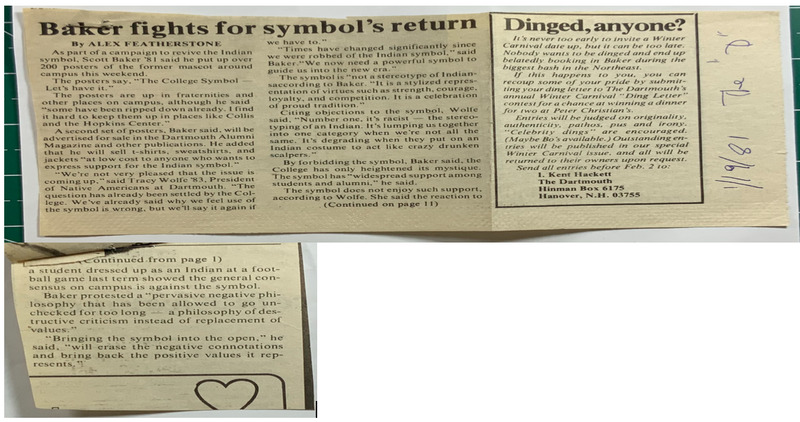 Pro-Indian Symbol Movement in 1981
Pro-Indian Symbol Movement in 1981 Dartmouth student Scott Baker put up images with the indian symbol in 1981
-
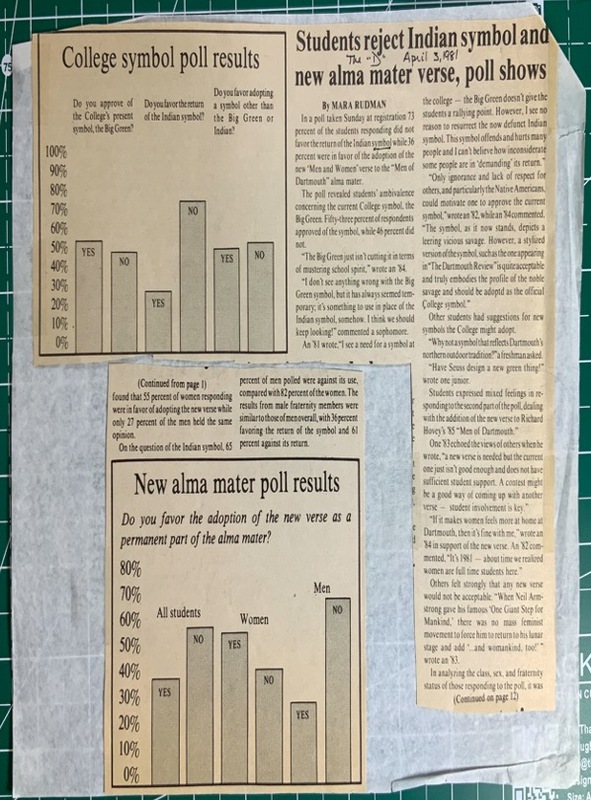 Poll Showing Student Support for Indian Mascot Remained Low, 1981
Poll Showing Student Support for Indian Mascot Remained Low, 1981 Students were polled and overwhelming rejected returning the Indian mascot to Dartmouth's campus in 1981
-
 The Indian Symbol Remained Prevalent after the Mascot was Abolished
The Indian Symbol Remained Prevalent after the Mascot was Abolished Professor Michael Dorris and Grace Newell described actions by students that perpetuated the Indian symbol on campus
-
 Letter from Football Team Captains to Student Body, 1984
Letter from Football Team Captains to Student Body, 1984 The football team captains wrote a letter to the student body in support of the Indian symbol.
-
 Memo to President McLaughlin describing FIST Incident, 1984
Memo to President McLaughlin describing FIST Incident, 1984 This memorandum from the college counsel to President McLaughlin details the actions of a student group that called themselves "For Indian Symbol (FIST)" and supported the return of the symbol.
-
 Class of 1927 40 Year Reunion
Class of 1927 40 Year Reunion Class of 1927 at their 40th Reunion breaking peace pipes and dressed as Eleazar Wheelock and Native American student.
-
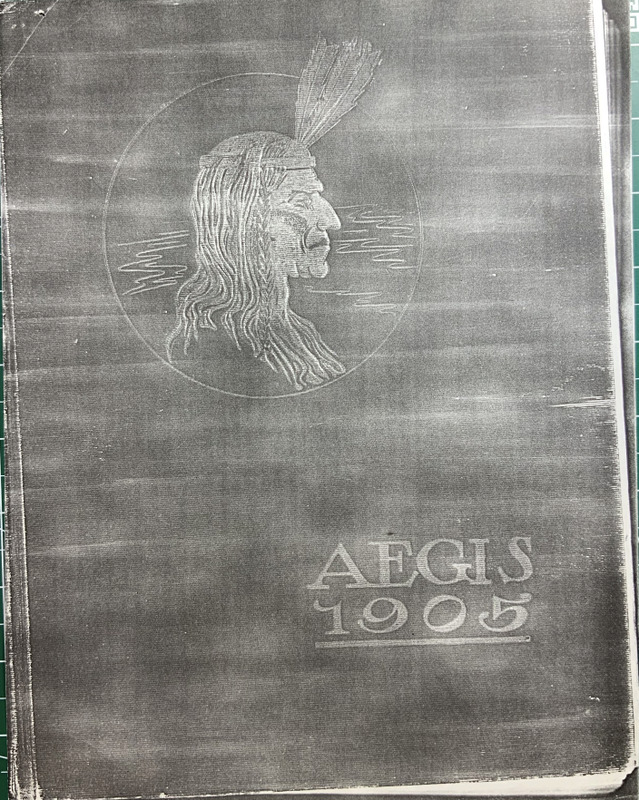 Aegis 1905
Aegis 1905 Agis Yearbook Cover 1905
 Dartmouth Sports Logo 2020 Big Green Dartmouth sports logo
Dartmouth Sports Logo 2020 Big Green Dartmouth sports logo Dartmouth Indian Logo Dartmouth D logo with Indian Head in center
Dartmouth Indian Logo Dartmouth D logo with Indian Head in center Native American Council Addresses Peers In a letter to an undated freshman class, likely at the end of the 1970s, the Native American Council acknowledges that many members of the College community continue to embrace the Indian symbol even after its removal. The Council found it necessary to remind students that continued use of the symbol will “obscure problems never solved,” citing the higher rates of “disease, alcoholism, suicide, and poverty” in Native communities. The letter discourages the symbol’s use, much like the Board of Trustees discouraged its use in 1974, because no official action could be taken to remove a symbol never adopted by the College itself.
Native American Council Addresses Peers In a letter to an undated freshman class, likely at the end of the 1970s, the Native American Council acknowledges that many members of the College community continue to embrace the Indian symbol even after its removal. The Council found it necessary to remind students that continued use of the symbol will “obscure problems never solved,” citing the higher rates of “disease, alcoholism, suicide, and poverty” in Native communities. The letter discourages the symbol’s use, much like the Board of Trustees discouraged its use in 1974, because no official action could be taken to remove a symbol never adopted by the College itself. Administrative Response to Resistance In this letter to an undergraduate student in 1974, Assistant Dean of the Faculty Gregory Prince advocated for understanding the Native American position on removing the unofficial symbol and mascot. The student, it may be assumed from Prince’s response, was not receptive to listening to the Native American students and was sympathetic to keeping it. The letter demonstrates that while many were sensitive to listening to the Native Americans in wanting to change the symbol, some students were not quick or willing to see the removal of the symbol.
Administrative Response to Resistance In this letter to an undergraduate student in 1974, Assistant Dean of the Faculty Gregory Prince advocated for understanding the Native American position on removing the unofficial symbol and mascot. The student, it may be assumed from Prince’s response, was not receptive to listening to the Native American students and was sympathetic to keeping it. The letter demonstrates that while many were sensitive to listening to the Native Americans in wanting to change the symbol, some students were not quick or willing to see the removal of the symbol. National Context of Native American Voices This article from the Wall Street Journal puts the removal of the symbol in a national context. Around the time of Dartmouth’s removal of the Indian symbol, other schools had moved to abolish similar symbols. Additionally, debates on changing the names of national sports teams that referenced Native Americans, such as the Washington Redskins, were occurring. Native American voices were finally emerging nationally and not solely at Dartmouth. Not all attempts were successful, and Stanford University still had a Native American man dance at games even after the symbol was abolished.
National Context of Native American Voices This article from the Wall Street Journal puts the removal of the symbol in a national context. Around the time of Dartmouth’s removal of the Indian symbol, other schools had moved to abolish similar symbols. Additionally, debates on changing the names of national sports teams that referenced Native Americans, such as the Washington Redskins, were occurring. Native American voices were finally emerging nationally and not solely at Dartmouth. Not all attempts were successful, and Stanford University still had a Native American man dance at games even after the symbol was abolished. Statement from the Board of Trustees In 1974, the Dartmouth Board of Trustees released a statement announcing “use of the [Indian] symbol in any form to be inconsistent with present institutional and academic objectives of the College in advancing Native American education.” The Board took no official action on removing the symbol because the College never formally adopted the symbol. Instead, the Board made it “a matter of individual conscience.” This statement is generally considered the official removal of the Indian symbol since it was the first time that the Board of Trustees discouraged its use.
Statement from the Board of Trustees In 1974, the Dartmouth Board of Trustees released a statement announcing “use of the [Indian] symbol in any form to be inconsistent with present institutional and academic objectives of the College in advancing Native American education.” The Board took no official action on removing the symbol because the College never formally adopted the symbol. Instead, the Board made it “a matter of individual conscience.” This statement is generally considered the official removal of the Indian symbol since it was the first time that the Board of Trustees discouraged its use. Initial Disuse of the Symbol The two newspaper articles from 1972, “DCAC To Eliminate Use of Indian Symbol” and “Native Americans’ Requests Honored,” announce some victories on the path to stop using the Indian symbol. “Nine and one half months after receiving the policy statement of the Native Americans at Dartmouth,” the College began the process of removing the symbol from stationary, uniforms, and changed Dartmouth’s nickname from the “Dartmouth Indian” to “Big Green.” Not all requests in the original policy statement, such as removing murals depicting Indians, were honored, and it would be several years until the symbol was completely disused on campus.
Initial Disuse of the Symbol The two newspaper articles from 1972, “DCAC To Eliminate Use of Indian Symbol” and “Native Americans’ Requests Honored,” announce some victories on the path to stop using the Indian symbol. “Nine and one half months after receiving the policy statement of the Native Americans at Dartmouth,” the College began the process of removing the symbol from stationary, uniforms, and changed Dartmouth’s nickname from the “Dartmouth Indian” to “Big Green.” Not all requests in the original policy statement, such as removing murals depicting Indians, were honored, and it would be several years until the symbol was completely disused on campus. Introduction to the Discussion This article makes it clear that the Dartmouth administration was willing to listen to the claims made by the Native American students in their policy statement. College provost Louis Morton liked “the tone of the document” and thought that it was “a reasonably worded statement.” These words are a reminder that minorities like the Native American students needed to be careful in how they presented their grievances.
Introduction to the Discussion This article makes it clear that the Dartmouth administration was willing to listen to the claims made by the Native American students in their policy statement. College provost Louis Morton liked “the tone of the document” and thought that it was “a reasonably worded statement.” These words are a reminder that minorities like the Native American students needed to be careful in how they presented their grievances. Explanation Requested by the Athletic Council This letter was written five years after the College officially removed the symbol. In the letter, the Native American Council mentions that nobody objected to the symbol until it was used for athletic home game jerseys in 1970. Coincidentally, use of the symbol by the sports teams on jerseys overlapped with the admission of more Native American students to Dartmouth, and both of these events likely contributed to the development of the 1971 policy statement.
Explanation Requested by the Athletic Council This letter was written five years after the College officially removed the symbol. In the letter, the Native American Council mentions that nobody objected to the symbol until it was used for athletic home game jerseys in 1970. Coincidentally, use of the symbol by the sports teams on jerseys overlapped with the admission of more Native American students to Dartmouth, and both of these events likely contributed to the development of the 1971 policy statement. Importance of Native Voices The article from October of 1969 notes how in the 200-year history of the College, “only a dozen” Native students graduated from Dartmouth. Without a Native American voice on campus, the symbol became “the major personification of the spirit [of the College.]” In the 1969-1970 school year, the four Native Americans on campus—three of whom were freshmen admitted after the College reaffirmed its commitment to educating Native students—began the fight against the symbol.
Importance of Native Voices The article from October of 1969 notes how in the 200-year history of the College, “only a dozen” Native students graduated from Dartmouth. Without a Native American voice on campus, the symbol became “the major personification of the spirit [of the College.]” In the 1969-1970 school year, the four Native Americans on campus—three of whom were freshmen admitted after the College reaffirmed its commitment to educating Native students—began the fight against the symbol. Native American Students’ Policy Statement This policy statement, written in 1971, was the first formal declaration by Native students that the “various traditions and symbols used by the Dartmouth Community are based upon insensitivity to the culture of Native American Peoples.” Believing the symbol was “a mythical creation of a non-Indian culture,” the Native American students requested that the College remove any depiction of Indians from campus and stop using the Indian as a mascot.
Native American Students’ Policy Statement This policy statement, written in 1971, was the first formal declaration by Native students that the “various traditions and symbols used by the Dartmouth Community are based upon insensitivity to the culture of Native American Peoples.” Believing the symbol was “a mythical creation of a non-Indian culture,” the Native American students requested that the College remove any depiction of Indians from campus and stop using the Indian as a mascot. Land O'Lakes new logo Land O'Lakes new logo, changed April 2020
Land O'Lakes new logo Land O'Lakes new logo, changed April 2020 Shawmut Bank Debates, 1994 Several newspaper articles from New England described Shawmut Bank's deliberations over whether to open a Hanover branch.
Shawmut Bank Debates, 1994 Several newspaper articles from New England described Shawmut Bank's deliberations over whether to open a Hanover branch. Freshman class in 1983 described "confusion" at the Dartmouth community's rejection of the Indian symbol Newspaper article describing a conversation between Dartmouth community members (largely students) regarding the Indian symbol
Freshman class in 1983 described "confusion" at the Dartmouth community's rejection of the Indian symbol Newspaper article describing a conversation between Dartmouth community members (largely students) regarding the Indian symbol Campus reaction to skaters An article in the Dartmouth Alumni Magazine recounting the campus strife over the Indian symbol as well as the holding of a "Moratorium Day."
Campus reaction to skaters An article in the Dartmouth Alumni Magazine recounting the campus strife over the Indian symbol as well as the holding of a "Moratorium Day." Dartmouth women dress as Native Americans at hockey game, 1979 Articles describing an event when two freshman women dressed as Native Americans and skated on the ice with the Dartmouth hockey team.
Dartmouth women dress as Native Americans at hockey game, 1979 Articles describing an event when two freshman women dressed as Native Americans and skated on the ice with the Dartmouth hockey team. Freshman students in the fall of 1983 displayed a "Dartmouth Indians" banner at a football game The article describes and shows the event when Dartmouth students displayed a banner with the Indian symbol at a football game.
Freshman students in the fall of 1983 displayed a "Dartmouth Indians" banner at a football game The article describes and shows the event when Dartmouth students displayed a banner with the Indian symbol at a football game. Dartmouth upperclassmen condemned the freshman class's actions in the fall of 1983 Mark Montgomery described his disgust at the freshman students' actions
Dartmouth upperclassmen condemned the freshman class's actions in the fall of 1983 Mark Montgomery described his disgust at the freshman students' actions Pro-Indian Symbol Movement in 1981 Dartmouth student Scott Baker put up images with the indian symbol in 1981
Pro-Indian Symbol Movement in 1981 Dartmouth student Scott Baker put up images with the indian symbol in 1981 Poll Showing Student Support for Indian Mascot Remained Low, 1981 Students were polled and overwhelming rejected returning the Indian mascot to Dartmouth's campus in 1981
Poll Showing Student Support for Indian Mascot Remained Low, 1981 Students were polled and overwhelming rejected returning the Indian mascot to Dartmouth's campus in 1981 The Indian Symbol Remained Prevalent after the Mascot was Abolished Professor Michael Dorris and Grace Newell described actions by students that perpetuated the Indian symbol on campus
The Indian Symbol Remained Prevalent after the Mascot was Abolished Professor Michael Dorris and Grace Newell described actions by students that perpetuated the Indian symbol on campus Letter from Football Team Captains to Student Body, 1984 The football team captains wrote a letter to the student body in support of the Indian symbol.
Letter from Football Team Captains to Student Body, 1984 The football team captains wrote a letter to the student body in support of the Indian symbol. Memo to President McLaughlin describing FIST Incident, 1984 This memorandum from the college counsel to President McLaughlin details the actions of a student group that called themselves "For Indian Symbol (FIST)" and supported the return of the symbol.
Memo to President McLaughlin describing FIST Incident, 1984 This memorandum from the college counsel to President McLaughlin details the actions of a student group that called themselves "For Indian Symbol (FIST)" and supported the return of the symbol. Class of 1927 40 Year Reunion Class of 1927 at their 40th Reunion breaking peace pipes and dressed as Eleazar Wheelock and Native American student.
Class of 1927 40 Year Reunion Class of 1927 at their 40th Reunion breaking peace pipes and dressed as Eleazar Wheelock and Native American student. Aegis 1905 Agis Yearbook Cover 1905
Aegis 1905 Agis Yearbook Cover 1905